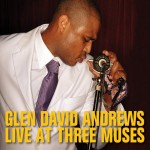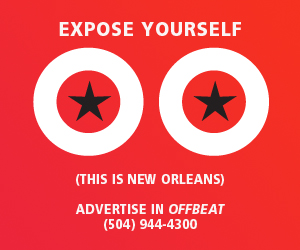Anyone who’s witnessed Glen David Andrews on a good night knows he is capable of being the most charismatic performer in New Orleans. Up until now, you had to be there to appreciate his talent, though. His 2004 Dumaine Street Blues demonstrated his capabilities playing traditional jazz and New Orleans street favorites quite well but didn’t distinguish itself from many similar recordings. 2009’s live Walking Through Heaven’s Gate captured GDA’s impressive gospel roots, but technical difficulties made the album a less than perfect medium for his galvanic talents. Finally, Live at Three Muses captures the full force of GDA’s live act for posterity. The Frenchmen Street club decided to record all of its regular acts over the summer of 2011 with the idea of putting together a compilation record. In the process, Andrews managed to condense his peripatetic performance into the perfect live recording.
Andrews can be sprawling from set to set, brilliantly unpredictable and over the top. He takes so many chances that his moves don’t always work, but he adjusts to the moment so it’s always just a short wait until the next spectacular turn. But on this record, he exercised outstanding discipline in charting a program that takes him through the full range of New Orleans styles he excels at without taking a breath.
Andrews starts out with “Basin Street Blues,” a traditional New Orleans jazz vehicle that has been a live staple for over 80 years, but his delivery is straight out of tonight. He uses the song to celebrate the New Orleans music scene as it is right now:
Preservation Hall will be here to greet you
Dr. John will be here to greet you
Charmaine Neville will be here to greet you
Aaron Neville will be here to greet you
Cyril Neville will be here to greet you
And Trombone Shorty will be here to swing you…
John Boutte will be here to greet you
James Andrews will be here to greet you
Glen Andrews will be here to greet you
Terence Blanchard will be here to greet you
Papa Grows Funk will be here to greet you
The music of Mahalia Jackson will be here to greet you
The spirit of Louis Armstrong will be here to greet you
Andrews delivers these lines like a hip-hop MC working up a crowd with neighborhood shout-outs, then moves into a recasting of Boutte’s “Treme Song,” personalizing it with new lyrics and an urgent, double-time arrangement that surges into the Andrews original “Flat Like That (Get That Gator),” a manic dance piece that moves on drummer Jamal Watson’s relentless pulse.
Andrews then breaks it down with a meditative, gospel-influenced take on “At the Foot of Canal Street,” framed by fervent piano accompaniment from Kyle Roussel. This radically transformed version of the song is typical of the way Andrews deconstructs material, basically taking the title and a few phrases and turning it into his own vehicle. It’s another example, along with the frantic pace of his beats, of how contemporary Andrews’ instincts are. Just as hip-hop artists treat preexisting songs as readymades for their own compositions, Andrews appropriates freely, dropping pieces from disparate places into the mix. His genius lies in the fact that he’s never copying other people’s music, but always reimagining it. When he says, “How about it for John Boutte and Paul Sanchez for writing such a beautiful song?” it’s more like a name check than an acknowledgement of the song itself, which is recognizable in Andrews’ version only by the use of the title.
Having given the crowd a breather, GDA launches immediately into the driving riff of “Rock Star (Like Mike),” written with cousin Trombone Shorty and Mike Ballard, which segues to the heavy brass instrumental “Whatever Happened to Peanut,” written with another cousin, trombonist Revert “Peanut” Andrews. The crowd is so hyped by the end of this track that you can hear people screaming out the melody line. Suddenly, we’re into another of GDA’s reimaginings, this time a radical revision of Monk Boudreaux’s “Bury the Hatchet” which becomes a medium for Andrews’ riveting sermon about black-on-black crime in New Orleans.
Professor Longhair’s “Tipitina” gets about the most straightforward rendition of anything on the album, a great medium for both Roussel and Watson. As Roussel plays his solo choruses, Andrews goes into a reverie, sending out a message to a 93-year-old female fan from Chicago with cancer. GDA is in the pulpit, declaring, “I believe someday we’re going to find a cure for cancer,” then asking the audience to “put your hands up for everyone who’s suffered from this horrible disease.” This kind of metaphysical shift seems to occur spontaneously in a GDA show and offers the perfect set- up for a nearly 10-minute-long gospel medley. Andrews is most at home in this medium, and while it lacks the authenticity of Walking Through Heaven’s Gate, this performance employs the crowd- pleasing usefulness of gospel material in a pop context, leading into “Saints” and the “Who Dat” chant. Heading from one old school to another, GDA leads the band into a Brothers Johnson groove based on “I Want You.” This is the real climax of the show, with a Dr. John tribute offered as a little lagniappe: “I will, I will melt your heart like butter.”
Some complain that GDA merely mines preexisting genres of New Orleans music for narrow focused tourist mongering. I hear a transformational character in New Orleans music, redefining classic works by bringing contemporary elements to them and infusing them with the force of his personality. When you hear a performer say “Somebody scream!” usually you’re getting a rote suggestion devoid of context or imperative. When GDA addresses the crowd, he’s issuing a personal command and he gets a personal response. He’s taken the rote out of the tradition. What you get at a good GDA performance is something akin to the sheer athleticism and unrelenting flow of a Celtics-Lakers NBA final. And finally, thanks to Three Muses and a brilliant engineering job by Michael Seaman, you can bring that experience home with you.





